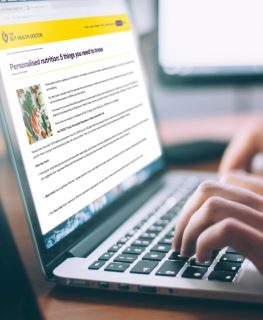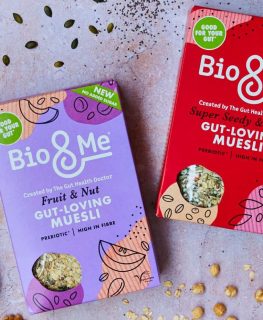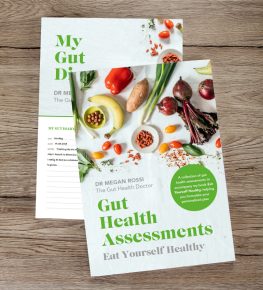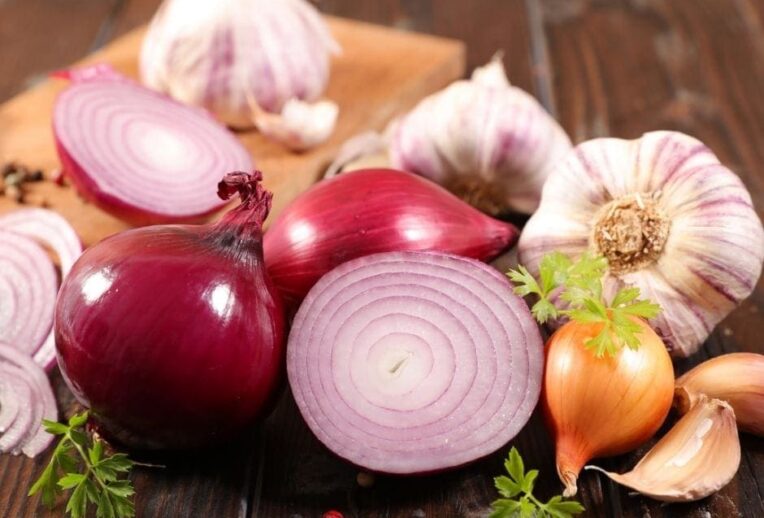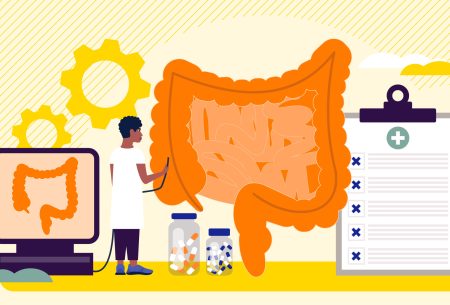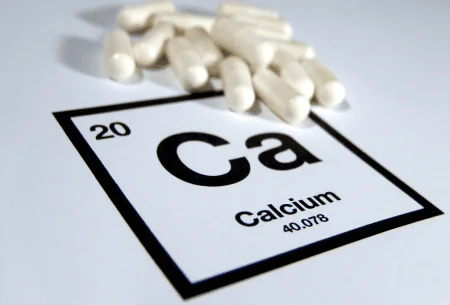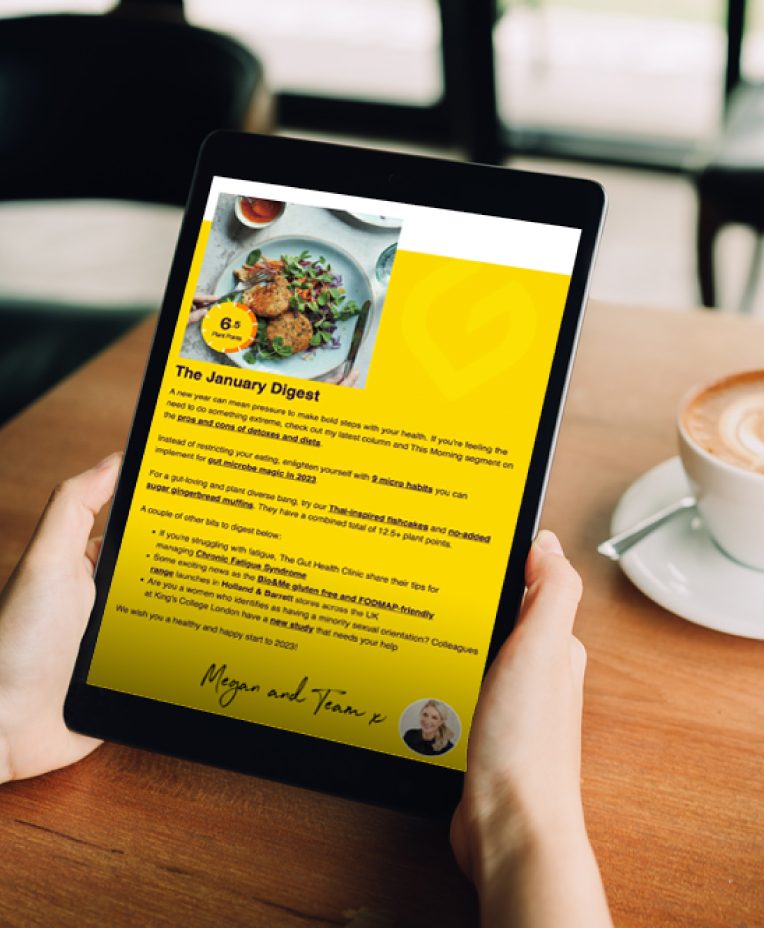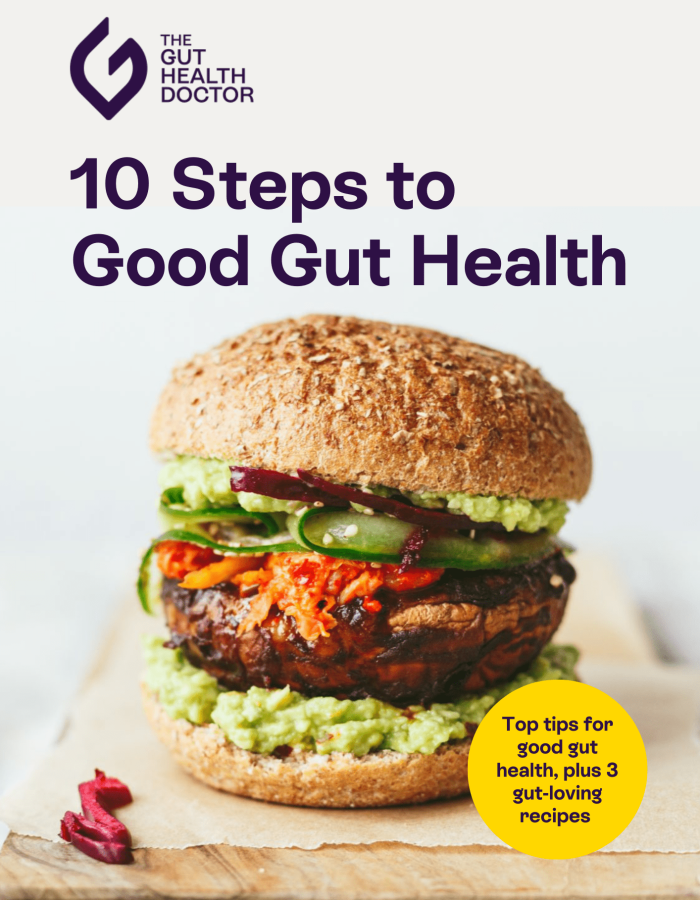Recap definition of FODMAPs
The low FODMAP diet is a special type of diet that restricts foods high in FODMAPs. FODMAP is an acronym that refers to a group of sugars (carbohydrates) that are found in foods that are readily fermented and poorly absorbed in the gut. The acronym stands for:
- Fermentable
- Oligosaccharides
- Disaccharides
- Monosaccharides
- And
- Polyols
As FODMAPs are readily fermented and poorly absorbed, it can cause extra gas and fluid to be drawn into the intestines. This leads to symptoms such as reflux, bloating, altered stools (diarrhoea, constipation or a mixture of both) and wind. The extra gas causes the intestinal wall to stretch and expand. Because people with IBS have a highly sensitive gut, ‘stretching’ the intestinal wall causes exaggerated sensations of pain and discomfort.
FODMAPs are found in a wide range of foods, such as fruits, vegetables, bread, cereals, nuts, legumes, dairy (containing lactose) and food additives. The low FODMAP diet is a therapeutic diet that avoids these highly fermentable carbohydrates (or FODMAPs), with the aim of resting the gut and managing symptoms. This diet is only to be followed with the supervision of a dietitian, who can ensure patients are safe to start such a restrictive diet and that all first-line advice for managing IBS has been trialled before.
The low FODMAP diet contains 3-phases:
- Strict low FODMAP diet to induce symptom relief for 2-8 weeks
- Reintroduction of certain high FODMAP foods to identify sensitivities to individual subgroups for 6-8 weeks.
- Personalisation of FODMAPs to prevent restrictions and to expand the diet for gut diversity
For more information about the diet take a look at our full article on the low FODMAP diet.
If the strict low FODMAP diet works to relieve symptoms, then why do we try to reintroduce these foods back into the diet?
Foods that contain FODMAPs are super nutritious, they contain fibre, prebiotics and polyphenols. These help to support the balance of our gut function and our gut microbiota, which we know has an important role in many aspects of our health, from our immune function to our mood. Evidence shows that the levels of our beneficial bacteria decline on the low FODMAP diet.
This is why the reintroduction of high FODMAP foods is so important. The end goal is to ensure that we can discover what our key triggers are to the IBS symptoms in order to eliminate them and increase the variety of the foods tolerated in the diet. This can help achieve a diet that nourishes our gut microbiota and enables us to thrive.
What is the best way to start the FODMAP challenges in the reintroduction phase?
If symptoms have improved following the initial phase of the low FODMAP diet, then a dietitian will guide us through the next phase in the process. This is called the reintroduction phase. As we mentioned before, this stage is to help identify which FODMAPs trigger IBS symptoms. In this phase we still must remain on the low FODMAP diet as per phase 1 whilst challenging these high FODMAP foods. This helps give us clear results and keeps possible symptom triggers to a minimum.
We start by choosing the FODMAP rich food that we would like to test for each FODMAP subgroup:
- Excess fructose
- Lactose
- Polyols (sorbitol and mannitol)
- Fructose
- Fructans (one each for onion, garlic and grains)
- GOS
Start by using a small portion of the FODMAP challenge food at first and gradually increasing this to a typical serving size. In the 24 hours after eating the challenge food, we need to assess for any changes in symptoms (whilst also paying attention to any stress that may influence symptoms). If there are no symptoms between each challenge and portion increase, then we can move onto the next increase or challenge. This should look something like this:
Fructans (onion)
- Day 1: Challenge ⅛ onion (amber serve)
- Day 2: Challenge ¼ onion (red serve)
- Day 3: Challenge ½ onion (red serve)
Wait for 3 symptom free days before starting the next challenge
However, if there have been symptoms within the following 24 hours after the FODMAP challenge or following the increase of a FODMAP food then this would indicate that this FODMAP group may be a trigger. It can also tell us about the amount that we may or may not be able to tolerate of the challenge food. See below for example, using another FODMAP group:
Sorbitol
- Day 1: Challenge ¼ small avocado (amber serve)
- Day 2: Challenge ½ small avocado (red serve)
- Day 3: Changes in IBS symptoms
Wait for 3 symptom free days before starting the next challenge
These findings would indicate that this person can tolerate an amber serve of sorbitol or avocado, but at this point in time they cannot tolerate a red serving. Following this and the end of any FODMAP challenge, we recommend a three day resting period using just the low FODMAP diet. This same FODMAP group can be re-tested if it is a concern or if there may be overlapping factors such as stress that might have influenced the results of the challenge. Be sure to record the outcomes of the FODMAP challenge and the serving sizes used.
Hopefully this provides an idea as to how the reintroduction phase works!
Top tips to help you complete this phase
1. Keep positive. Some people can find the re-introduction phase daunting if they have managed to control their symptoms whilst following phase 1. But try to see the next phase as a positive. This is where we can start to increase the variety in our diet and hopefully include some of our favourite foods again. Trying to be positive during this phase will help to relax the gut-brain axis too. Planning ahead may help to build some motivation and excitement.
2. Remember that some mild fluctuations in symptoms (such as bloat or wind) may occur during the challenges. This is okay. Make a note of the severity with the serving size. If these become severe, then take a three day resting period to allow the gut to rest.
3. Remain on a low FODMAP diet whilst you are going through each challenge – wait until you’ve completed all the challenges before adding foods back in. You should have been provided with some tips and resources to help you have an enjoyable and nutritious low FODMAP diet.
[elementor-template id=”2919″]
4. Take notes. As we mentioned previously, it can be motivating to plan ahead for the FODMAP challenges. This can also help us to be prepared and make the most of this phase to get clear results. Jot down the challenges for each FODMAP group, this can be done with the help of a dietitian and the Monash App. There are also some great resources at the Field Doctor website.
5. Keep other symptom triggers constant. If we are having lots of caffeine, alcohol or fatty foods during a challenge, it may make it harder to interpret our response to the high FODMAP food. Sticking to our usual intake of these foods during this period can help to reduce this risk. Also be aware of any background life stresses whilst following the reintroduction phase as this can affect the challenge outcomes too.
Phase 3: Personalisation of results
Once all FODMAP groups have been challenged in phase 2, we are ready to commence the final phase. This is the personalisation phase. During this phase, we will conduct some experiments to understand how the food we want to eat can fit back into our diet for the long-term. This can help us liberalise our diet and maximise the variety of food we can tolerate to support our gut health.
Here are some questions we want to think about:
- How much of this food would I have on a typical day?
- How much can I tolerate?
- What else can I combine with it?
The best way to practice combining foods in this phase is to start with one high FODMAP food per meal. This will allow our gut to have a smaller break between meals or experiments. It is likely that we may come across combinations of food that trigger gut symptoms. If this happens there is no need to worry. Simply return to a low FODMAP diet for three days to allow time for gut rest, then continue with a different combination.
Make a note of the meals that do and do not work, as an accurate record will help to avoid repeating food combinations and allow us to build a detailed picture of what works for us. With this, we can start to form new habits around food choices and meal times that can help us transition out of the final phase of the low FODMAP diet.
Remember, FODMAP tolerance can change over time. This means that a food tolerated now, may not be tolerated in future and vice versa. These changes can be as a result of alterations in our gut microbiota but also other influencing factors such as medications (such as antibiotics), illness, alcohol, stress and anxiety. This is why it can be helpful to re-challenge previous foods that were once not tolerated every few months (or longer). A dietitian can help you navigate the reintroduction of FODMAPs safely and efficiently.
FODMAP stacking
FODMAP stacking is when multiple low FODMAP foods build up in our large intestine over time. This can happen with all low FODMAP foods, except for those in the lactose subgroup, as these are digested differently.
This is normal as it takes 12-48 hours for food to travel from our mouth to our anus. However, for some people this may cause gut symptoms despite following a low FODMAP diet. It can be difficult to create guidance on FODMAP stacking, as each person will have different tolerances to different FODMAP subgroups. However some simple tips can help to limit the risk of FODMAP stacking:
- Make the most of foods with no or minimal FODMAPs. These can be found on the Monash FODMAP app, just look for the green traffic light serving.
- Mix it up. If we consume the same types of FODMAP containing foods at each meal then we may increase our chances of stacking. Focus on variety by choosing a mixture of no or minimal FODMAP foods. This can also help increase those plant-points too!
- Be mindful of fruit intake as these contain multiple different FODMAPs, increasing the likelihood of stacking. Limit to two pieces of green fruits per day and make the most of FODMAP free fruits such as strawberries, grapes, mandarins and oranges.
- Space out your meals by leaving 3-4 hours between each eating episode. This can help to reduce FODMAP snacking. But don’t go hungry, try point one if a snack attack arises.
Summary
Phase 2 of the low FODMAP diet involves individual challenges carried out over a period of time. Working with your dietitian during this phase can be so important to help you keep on track and understand your results fully. Patience and perseverance is needed – try not to rush it, or to lose sight of the fact that you’re almost through the process. After all the challenges have been completed you should be able to start reintroducing the higher FODMAP foods up to your own personal tolerance level, and starting to enjoy a more diverse diet, whilst maintaining good IBS symptom control.





